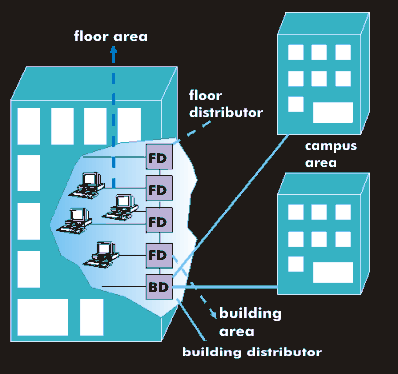building wiring
The building cabling, the secondary cabling, integrates the floor networks and the floor cabling and connects the individual rooms to the campus network or the access network. The secondary cabling comprises the area between the building distribution board( BDS) and the floor distribution board(FDS) and depends on the respective network level.
The ISO/IEC11801 and EN 50173 cabling standards for structured cabling recommend a maximum length of 500 m between distributors.
In the secondary area, the mixed use of multimode fibers (62.5/125 µm) and UTP cables ofcategories 3, 4 and 5 or STP cables is recommended. The high bandwidth available up to the floor distributor and the elimination of active components speak in favor of the use of FO. Copper cabling offers cost advantages with low usable bandwidths. Copper cables are usually laid in star topology in the secondary area, FO cables in star structure, but also in ring topology.
From the building cabling is required: Modularity in the cabling of floors or areas, construction and operation of walkable building and floor distributors, maintainable cable system for quick troubleshooting, network-independent cabling and adaptability to the existing riser areas.
All this leads to different solution possibilities depending on the building structure and the defined requirements.

